How many Indians work abroad? We have no answer to this question even today. However, available evidence indicates that the state of Kerala in India has the highest number of emigrants in the Gulf countries.1
In order to make an assessment of the emigrants from Kerala to the Gulf, the Centre for Development Studies (CDS) conducted four large-scale surveys over the last 10 years — in 1998, 2003, 2007, and 2008. This essay is based on the Kerala Migration Survey (KMS) 2008, funded by the Department of Non-Resident Keralite Affairs, the Government of Kerala, and the Ministry of Overseas Indian Affairs, Government of India.2 In this survey, the sample size was enhanced to 15,000 households from 10,000 households in the three earlier migration surveys. The increase in sample size — with a minimum of 1,000 households in every district of Kerala — is expected to yield reliable migration estimates at the district and taluk levels in Kerala.
These estimates are made on the basis of answers to the following question: Has any person who was a usual resident of this household (HH) migrated out of Kerala and is still living outside India? Those who are still living outside India are called emigrants. Similarly, those who worked abroad and returned to Kerala are called return emigrants.
The sample consists of 300 localities (Panchayats or Municipal wards). From each locality 50 HHs were selected for canvassing. Estimation is done at the Taluk level. Thus for a Taluk we have:
-
ri = Number of Emigrants in the sample households in the ith locality
-
hi = Number of sample HHs in the ith locality (50)
-
Hi = Total number of HHs in the sample locality in 2008
-
H = Total number of HHs in the Taluk in 2008
According to Table 1, the number of Kerala migrants living outside India in 2008 was 2.19 million. The corresponding number in 1998 was 1.36 million. During the 10-year period 1998-2008, the number of emigrants from Kerala has increased by 830,000 (See Figure 1).

Migration begets migration; emigration begets return emigration. The greater the extent of emigration, the greater the potential extent of return emigration. Return emigration is a built-in aspect of the emigration process. This is particularly true of Gulf migration, where almost all emigration is of short duration and temporary in nature. Return emigration statistics given in Table 1 tell this story convincingly. The number of return emigrants rose from 740,000 in 1998 to 1.16 million in 2008, the net increase being 420,000 during the period 1998-2008. The number of Non-Resident Keralites (NRK=EMI+REM) in 2008 was 3.35 million, while the corresponding number in 1998 was 2.1 million. Thus the number of NRKs increased by 1.25 million during 1998-2008.
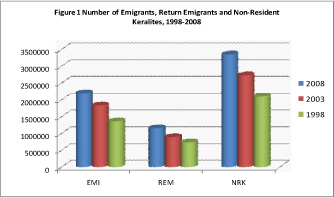
The number of emigrants per 100 households increased from 21.4% in 1998 to 29% in 2008. Similarly, the number of return emigrants per 100 households increased from 11.6% in 1998 to 15.3% in 2008 (Figure 2).
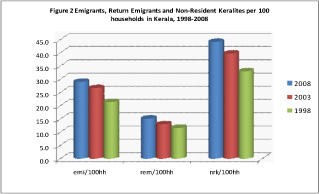
Using the information collected from the earlier migration surveys, we have constructed the trend in emigration from Kerala. The data is given in Table 2 (Figure 3).
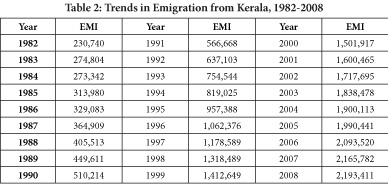
Estimates of the number of emigrants by district is much more reliable in KMS 2008 than in earlier surveys, as the number of sample households was more than 1,000 in each of the 14 districts. Figure 4 indicates that Malappuram district had the largest number of emigrants from Kerala — 335,000 out of a total of 2.19 million (15.3%).
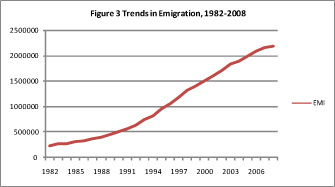
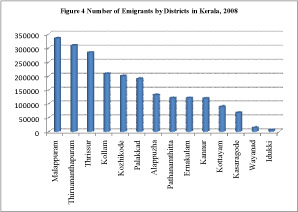
Kerala witnessed accelerated emigration at the start of the 1970s. From then on, the Gulf countries have been the principal destination of emigrants. The state of affairs remained more or less the same in 2008. Kerala emigration, even today, is essentially emigration to the Gulf countries. In 1998, a Gulf country was the emigration destination for 93.9% of Kerala emigrants, declining to 88.5% in 2008.
The changes within the Gulf region are more marked. Saudi Arabia was the principal destination in 1998, with 37.5% of Kerala’s emigrants arriving there. The proportion of emigrants from Kerala to Saudi Arabia declined to 26.7% in 2003 and further dropped to 23% in 2008. However, the number of Kerala emigrants in Saudi Arabia has remained stable; it has not declined at all during the ten-year period. On the other hand, the United Arab Emirates (UAE) has received a rising proportion of Kerala emigrants — from 31% in 1998 to 41.9% in 2008 (Figure 5).
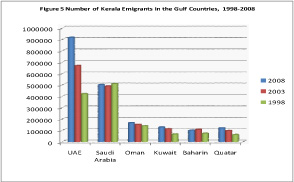
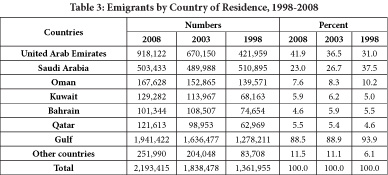
According to the 2001 Census, 56.3% of Kerala’s population is Hindu, 19% is Christian, and 24.7% is Muslim. However, Muslims make up the plurality of the emigrants, with 41.1%, followed by Hindus with 37.7%, and Christians with 21.2% (Table 4).

The majority of the migrants in Kerala are males. The proportion of female emigrants from Kerala rose from 9.3% in 1998 to just 14.6% in 2008.
Conclusion
Kerala’s Gulf connection is so strong that even during the current global crisis, both emigration and remittances seem to be resilient. According to our recent study3 conducted for the Government of Kerala, even at the peak of the recession in the Gulf, when 173,000 emigrants returned to Kerala, 239,000 emigrants left Kerala to work in the Gulf, resulting in a net migration of 66,000. Similarly, the total cash remittances that Kerala households received in 2009 registered a modest increase of 7%.
1. S. Irudaya Rajan, “From Kerala to the Gulf: Impacts of Labour Migration,” Asia Pacific Migration Journal, Vol. 13, No. 4 (2004), pp. 497-509; S. Irudaya Rajan and G. Prabha Remya, “India,” Asia Pacific Migration Journal, Vol. 17, Nos. 3-4 (2008), pp. 277-86.
2. K.C. Zachariah and S. Irudaya Rajan, “Migration Monitoring Study, 2008: Emigration and Remittances in the Context of Surge in Oil Prices.” Research Report, Centre for Development Studies, Thiruvananthapuram, 2009.
3. K.C. Zachariah and S. Irudaya Rajan, “Impact of the Global Recession on Migration and Remittances in Kerala: New Evidences from the Return Migration Survey 2009.” Research Report, Centre for Development Studies, Thirivananthapuram (2009).
The Middle East Institute (MEI) is an independent, non-partisan, non-for-profit, educational organization. It does not engage in advocacy and its scholars’ opinions are their own. MEI welcomes financial donations, but retains sole editorial control over its work and its publications reflect only the authors’ views. For a listing of MEI donors, please click here.












